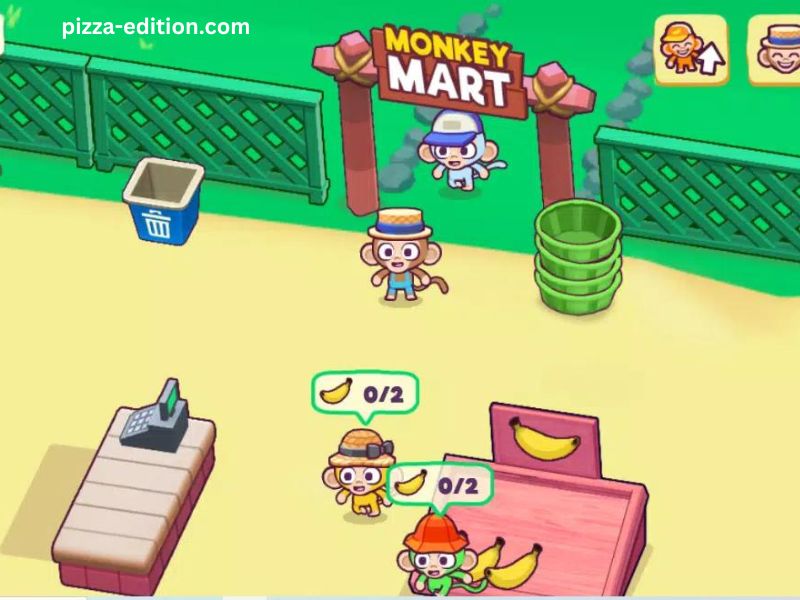In the ever-evolving world of mobile gaming, two genres have captured the imagination of casual gamers everywhere: idle simulators and resource management games. “Tiny Fishing” and “Monkey Mart” stand as prime examples of each genre’s appeal. While vastly different in concept and gameplay, both games offer a simple yet engaging experience that keeps players hooked for hours. This article delves into what makes these two games so addictive, their gameplay mechanics, and the unique elements that set them apart.
Tiny Fishing: A Simple Yet Engaging Idle Simulator
“Tiny Fishing” is a mobile game that thrives on simplicity and repetition. As an idle game, it puts the player in control of a virtual fisherman who casts a line into the water in search of fish. The player’s job? Catch as many fish as possible while upgrading equipment and skills to maximize their haul.
The Mechanics of Tiny Fishing
The gameplay is straightforward. When players cast their fishing line, they can control the depth it reaches by upgrading the line’s length. As they catch fish, they earn coins, which can be spent on upgrades for the fishing rod, the line, or the hooks. These upgrades improve the player’s ability to catch larger and rarer fish, allowing for a constant sense of progression.
The idle component comes into play when players aren’t actively playing. Even when the app is closed, the fisherman continues to catch fish, which the player can collect upon reopening the game. This passive reward system creates a sense of accomplishment without requiring constant attention.
Why Tiny Fishing is So Addictive
- Progression and Reward: Like most idle games, “Tiny Fishing” thrives on the concept of gradual progression. As players catch more fish and upgrade their gear, they feel a sense of accomplishment. The next goal—whether it’s a longer line or a rare fish—always feels within reach, encouraging players to keep playing.
- Casual Gameplay: “Tiny Fishing” is a game designed for short bursts of play. The act of casting the line takes just a few seconds, and players can log in, collect their rewards, upgrade their gear, and log out again without committing much time. This makes it perfect for casual gamers who want a quick, satisfying gaming experience.
- Idle Rewards: The idle mechanics mean that players feel rewarded even when they’re not playing. This passive gameplay ensures that returning to the game feels rewarding, as there are always fish to collect and upgrades to purchase.
Upgrades and Customization
A key element of “Tiny Fishing” is its upgrade system. Players can use the coins they earn to improve their fishing gear. Upgrading the fishing rod allows players to catch bigger fish, while improving the line length lets them reach deeper waters, where rare species reside. There’s also a hook upgrade that increases the number of fish a player can catch in one cast.
Additionally, “Tiny Fishing” offers cosmetic upgrades, such as different fishing rods and lures. While these don’t affect gameplay, they add a personal touch that allows players to customize their fishing experience.
A Relaxing Experience
One of the reasons “Tiny Fishing” has gained a loyal player base is its relaxing atmosphere. The simple visuals, calm music, and repetitive gameplay combine to create a soothing experience. Unlike fast-paced or competitive games, “Tiny Fishing” allows players to unwind and de-stress. There’s no rush, no time limits, and no real stakes—just the satisfaction of catching fish and improving gear over time.
Monkey Mart: A Resource Management Adventure
In contrast to the simple, idle gameplay of “Tiny Fishing,” “Monkey Mart” is a more complex resource management game that requires players to build and manage their own virtual supermarket. In this game, players control a monkey who runs a mart, selling various products to customers and expanding the store’s offerings.
The Premise of Monkey Mart
At the start of the game, players are given control of a small mart, where they must stock shelves, manage inventory, and satisfy customer demands. As the game progresses, players can expand their mart by adding new sections, such as a bakery, fruit stand, and dairy section. They can also hire staff (other monkeys) to help run the store, though managing employees introduces additional challenges.
Gameplay Mechanics
The core gameplay of “Monkey Mart” revolves around resource management. Players need to grow and harvest products, like bananas or tomatoes, and then stock the shelves with them. Customers come in and purchase these products, generating income that players can use to expand the mart and improve its operations.
The game also includes a time-management element, as players must balance growing products, stocking shelves, and tending to customers all at once. As the store expands, players must learn to delegate tasks and optimize workflows to keep everything running smoothly.
Why Monkey Mart is So Addictive
- Resource Management and Strategy: “Monkey Mart” is a game that challenges players to think strategically. Unlike “Tiny Fishing,” which can be played passively, “Monkey Mart” requires constant attention and decision-making. Players need to ensure they have enough stock to meet customer demand while also managing the resources needed to grow new products.
- Expansion and Growth: The game’s progression system keeps players engaged. As they earn money, players can expand their mart, unlocking new areas and products to sell. Each new section brings fresh challenges, such as managing different types of inventory and catering to new customer demands.
- Customizable Stores: Like “Tiny Fishing,” “Monkey Mart” allows players to customize their store. Players can choose different layouts and decorations to make their mart unique. This customization aspect adds a layer of personalization that enhances the player’s connection to the game.
Managing Customer Satisfaction
One of the key challenges in “Monkey Mart” is managing customer satisfaction. If customers have to wait too long or can’t find the products they want, their satisfaction level drops. Low satisfaction leads to fewer sales and less income, so players must keep a close eye on customer needs.
Hiring staff helps alleviate some of the pressure, as employees can restock shelves and tend to customers. However, managing staff introduces its own challenges, such as ensuring employees are assigned to the right tasks and keeping them happy.
A Delightful and Charming Experience
“Monkey Mart” stands out due to its charming art style and whimsical theme. The colorful, cartoonish graphics and cheerful soundtrack create a fun, lighthearted atmosphere. Players are not just running a store—they’re part of a vibrant, animated world filled with quirky characters and humorous interactions.
Comparing Tiny Fishing and Monkey Mart
While “Tiny Fishing” and “Monkey Mart” belong to different gaming genres, both share common elements that make them appealing to casual gamers.
Progression Systems
Both games use progression systems to keep players engaged. In “Tiny Fishing,” players progress by upgrading their fishing equipment, which allows them to catch bigger and better fish. In “Monkey Mart,” players expand their mart and unlock new areas, products, and challenges. This sense of growth and improvement is a key factor in why both games are so addictive.
Casual Appeal
“Tiny Fishing” and “Monkey Mart” cater to casual gamers who want a fun, low-pressure experience. Neither game requires a significant time investment, and players can pick them up and play for a few minutes at a time. This makes them ideal for people looking to relax and unwind.
Unique Gameplay Styles
Despite their similarities in appeal, the two games offer very different gameplay experiences. “Tiny Fishing” is an idle game, requiring minimal interaction, while “Monkey Mart” demands more attention and strategic thinking. Players looking for a more hands-on experience might prefer “Monkey Mart,” while those who enjoy idle mechanics will gravitate towards “Tiny Fishing.”
Conclusion
Both “Tiny Fishing” and “Monkey Mart” showcase the diversity of mobile gaming, offering vastly different experiences while still appealing to the casual gaming audience. “Tiny Fishing” provides a relaxing, idle experience where progression is slow but steady, while “Monkey Mart” offers a more dynamic, strategy-driven game where players must balance resources and customer satisfaction.
Whether you prefer the simple satisfaction of catching fish or the challenge of managing a bustling supermarket, both games provide an engaging escape from the stresses of daily life. With their charming graphics, addictive gameplay, and rewarding progression systems, “Tiny Fishing” and “Monkey Mart” are two mobile games that every casual gamer should try.




